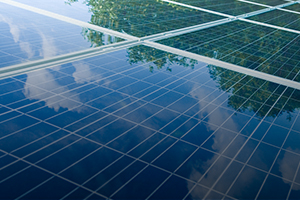Graphene Solar Panels

An international team of physicists has discovered a new property of pristine graphene that enables it to convert light into electricity and transfer the energy over long distances without an electronic charge. The finding could eventually lead to ultra-fast photodetectors and more efficient solar panels.
In most solar harvesting devices, an electrical current is generated at the junction of two dissimilar materials (such as a “p-n” junction) and moves through distinct regions of the two materials. In this research, it was discovered that a current can be generated in pristine graphene without the need for special junctions, and that it can be controlled by the shape and configuration of the graphene sheet.
Since they are only one atom thick, graphene sheets could be used to create semitransparent panels capable of capturing solar energy on windows and in other environments where typical solar panels are not suitable. In principle, graphene can also absorb any frequency of light, making it ideal for night vision, infrared imaging and bio-sensing applications. The team plans to study this new property over a range of infrared and other frequencies.
For information: Nathaniel Gabor, University of California Riverside, Materials Science and Engineering, 900 University Avenue, Riverside, CA 92521; phone: 951-827-5338; email: Nathaniel.gabor@ucr.edu; website: https://www.ucr.edu/